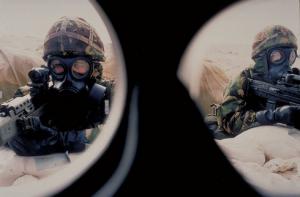Chemical warfareNew method helps identify chemical warfare agents
Chemical warfare agents are powerful noxious chemicals that have been used as weapons of mass destruction. Finding trace amounts of a chemical warfare agent in a sample can be challenging, especially if the agent and the liquid it is in are both water-repellant, which is often the case. A new method for extracting, enriching, and identifying chemical warfare agents from oils and other organic liquids could help government officials and homeland security protect civilians more effectively from their deadly effects. The method uses nanoparticles to capture the chemicals.

Contemporary soldiers in dhemical-protective gear // Source: theconversation.com
A new method for extracting, enriching, and identifying chemical warfare agents from oils and other organic liquids could help government officials and homeland security protect civilians more effectively from their deadly effects. The method, published in Journal of Chromatography A, uses nanoparticles to capture the chemicals.
Chemical warfare agents are powerful noxious chemicals that have been used as weapons of mass destruction. They can be nerve, blister, choking, blood, or psychochemical agents, acting on the nervous system, skin, lungs, blood, or brain, respectively. The most lethal are nerve agents classified as G-agents (sarin, soman, tabun, and cyclosarin) and V-agents (VX). Earlier this year, a senior Israeli official confirmed that Syria’s regime had used the nerve gas sarin against Israeli fighters. In 2013, the agent had been used to kill 1,400 people in Damascus.
The Chemical Weapons Convention was established to prevent attacks like this, and its enforcement relies on monitoring and identification of chemical warfare agents. The increasing use of agents like sarin means improved tests are needed to identify agents in samples taken from the environment so that people can be protected from their effects.
Finding trace amounts of a chemical warfare agent in a sample can be challenging, especially if the agent and the liquid it is in are both water-repellant, which is often the case. Elsevier says that in the new study, researchers from the Defense Research and Development Establishment in India developed a method that overcomes this challenge using iron oxide nanoparticles.
“The horrifying capabilities of chemicals like sarin have been shown in many incidents related to the military and terrorist activities,” said Dr. D. K. Dubey, corresponding author of the study from the Defense Research and Development Establishment. “Our research is an advancement in the state-of-the-art analytical techniques needed to verify the agents used in the field, to save mankind from the menace of chemical warfare agents.”
The researchers decorated iron oxide nanoparticles with a substance called poly methacyrlic acid-co-ehtylene glycol dimethacrylate. This made the particles more “sticky,” helping them attach more easily to the chemical warfare agent particles in the samples. They tweaked different aspects of the extraction method and eventually were able to identify the agents at low concentrations of about 0.1 micrograms per milliliter.
“Extracting hydrophobic chemicals, like these agents, from a hydrophobic background, like organic liquids, is a tough challenge to achieve analytically,” said Dr. Dubey. “But efficient and sensitive analytical methods are pivotal in the early detection and identification of toxic agents, so we wanted to take on this challenge. Our new method allows the efficient identification of chemical warfare agents in organic liquids; we hope it will be helpful for the international community involved in verifying and preventing the use of these devastating chemicals.”
— Read more in Varoon Singh et al., “Analysis of chemical warfare agents in organic liquid samples with magnetic dispersive solid phase extraction and gas chromatography mass spectrometry for verification of the chemical weapons convention,” Journal of Chromatography A 1448 (27 May 2016): 32-41 (doi: 10.1016/j.chroma.2016.04.058); also see D. K. Dubey, “How a simple method could help save people from nerve gas attacks,” Elsevier Connect (13 July 2016)
